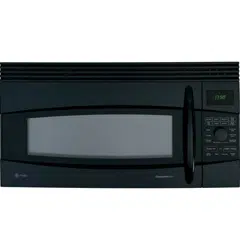Documents: Go to download!
User Manual
- User Manual - (English)
- Dimension guide - (English)
- installation instruction - (English)
- Operating Instructions
- Care and Cleaning
- Troubleshooting Tips
Table of contents
Owner’s Manual Microwave Oven
Operating Instructions
About the features of your oven.
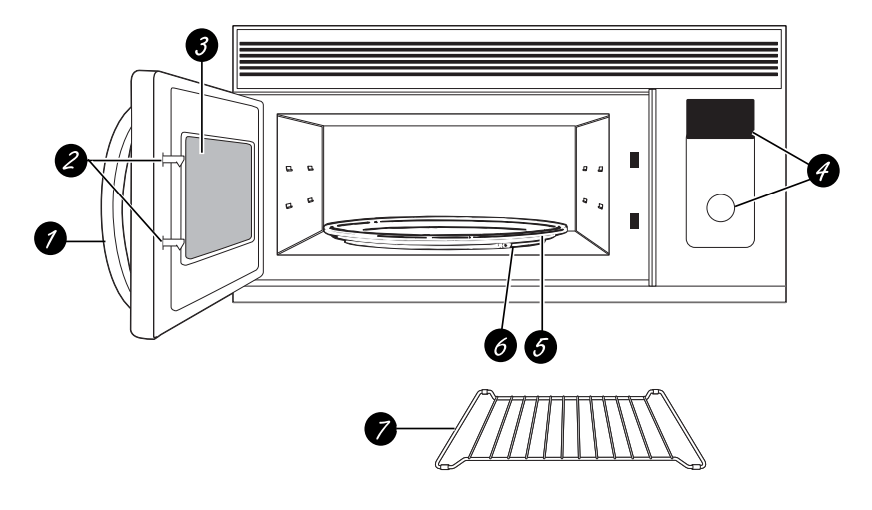
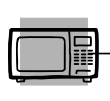 Features of the Oven
Features of the Oven
- Door Latch Release Handle.
- Door Latches.
- Window with Metal Shield. Screen allows cooking to be viewed while keeping microwaves confined in the oven.
- Control Panel and Selector Dial.
- Removable Turntable. Do not operate the oven in the microwave mode without the turntable and turntable support seated and in place.
- Removable Turntable Support. Do not operate the oven in the microwave mode without the turntable and turntable support seated and in place.
- Shelves. Use with CONVECTION BAKE, CONVECTION ROAST or COMBINATION FAST BAKE. (Do not use when microwave cooking.) For best results, use one shelf in the lower position and leave at least a 1-inch gap between the cooking dish and the sides of the oven. For two-level Baking or Fast Baking use both shelves.
About the cooking and warming features of your microwave/convection oven
You can cook by Microwave, Convection Bake, Convection Roast or Combination Fast Bake. Keep hot, cooked foods at serving temperature with the Warm feature.
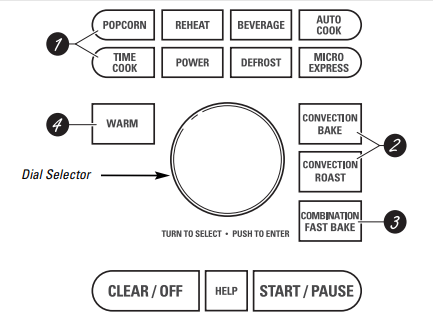
 Cooking Controls
Cooking Controls

Available cooking options
Microwave Cooking
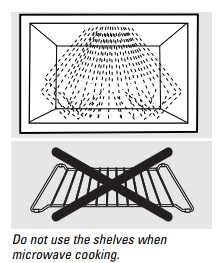
- Your oven uses microwave energy to cook by a set time or weight, or automatically by sensor.
- Sensor microwave works by detecting the increasing humidity released during cooking. The oven automatically adjusts the cooking time to various types and amounts of food.
| Cooking Method | Heat Source | Heat Conduction | Benefits |
| Microwave energy is distributed evenly throughout the oven for thorough, fast cooking of food. | Microwave energy. | Heat produced within food by instant energy penetration. |
Fast, high efficiency cooking. Oven and surroundings do not get hot. Easy clean-up. |
Convection Baking and Convection Roasting
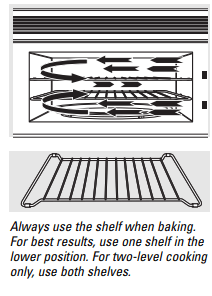
- During baking or roasting, a heating element is used to raise the temperature of the air inside the oven. Any oven temperature from 225°F. to 450°F. may be programmed. A fan gently circulates this heated air throughout the oven, over and around the food, producing golden brown exteriors and rich moist interiors. This circulation of heated air is called convection.
- Because the heated air is kept constantly moving, not permitting a layer of cooler air to develop around the food, some foods cook faster than in regular oven cooking.
| Cooking Method | Heat Source | Heat Conduction | Benefits |
| Hot air circulates around food to produce browned exteriors and seal in juices. | Circulating heated air (Convection). | Heat conducted from outside of food to inside. | Aids in browning and seals in flavor. Cooks some foods faster than regular ovens |
Combination Fast Baking

- Your oven also offers the option of Combination Fast Bake, using microwave energy along with convection cooking. You cook with speed and accuracy, while browning and crisping to perfection.
| Cooking Method | Heat Source | Heat Conduction | Benefits |
| Microwave energy and convection heat combine to cook foods up to 25% faster than regular ovens, while browning and sealing in juices | Microwave energy and circulating heated air. | Food heats from instant energy from penetration and heat conducted from outside of food. | Shortened cooking time from microwave energy, plus browning and crisping from convection heat. |
Warming

- The warming feature will keep hot, cooked foods at serving temperature. Always start with hot food. Use cookware and utensils that can withstand temperatures up to 230°F.
| Cooking Method | Heat Source | Heat Conduction | Benefits |
| Warm air circulates around food to keep previously cooked food warm. | Circulating heated air (Convection) | Warmth conducted from outside of food to inside. | Warmth conducted from outside of food to inside. |
About the time and auto microwave features.
Using the Dial
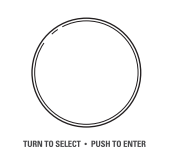
- You can make selections on the oven by turning the dial and pressing it to enter the selection.
- Pressing the dial can also be used in place of the START/PAUSE button for quicker programming of the oven.
Time Cook (Do not use the shelves when microwave cooking.)

Time Cook I
- Allows you to microwave for any time between 15 seconds and 95 minutes.
- Power level 10 (High) is automatically set, but you may change it for more flexibility.
- Press the TIME COOK button.
- Turn the dial to set the cook time and press the dial to enter.
- Change power level if you don’t want full power. (Press POWER. Turn the dial to select. Press the dial to enter.)
- Press the dial or the START/PAUSE button to start cooking.
- You may open the door during Time Cook to check the food. Close the door and press the dial or START/PAUSE to resume cooking.
- NOTE: You may change the cook time at any time during cooking by turning the dial. You may also change the power level by pressing the POWER button.
Time Cook II
- Lets you change power levels automatically during cooking. Here’s how to do it:
- Press the TIME COOK button.
- Turn the dial to set the first cook time and press the dial to enter.
- Change the power level if you don’t want full power. (Press POWER. Turn the dial to select. Press the dial to enter.)
- Press the TIME COOK button again.
- Turn the dial to set the second cook time and press the dial to enter.
- Change the power level if you don’t want full power. (Press POWER. Turn the dial to select. Press the dial to enter.)
- Press the dial or the START/PAUSE button to start cooking.
- At the end of Time Cook I, Time Cook II counts down.
- NOTE: You may change the cook time at any time during cooking by turning the dial. You may also change the power level by pressing the POWER button.
Micro Express Cook (Do not use the shelves when microwave cooking.)
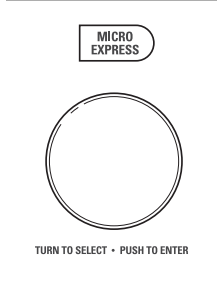
- This is a quick way to set and start cooking in 30 second blocks each time the MICRO EXPRESS button is pressed. The cook time may be changed by turning the dial at any time during cooking.
- The power level will automatically be set at 10 and the oven will start immediately.
- The power level can be changed as time is counting down. Press the POWER button, turn the dial and press to enter.
Fast Defrost (Do not use the shelves when microwave cooking.)
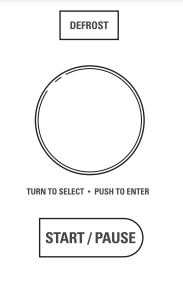
Fast Defrost automatically sets the defrosting times and power levels to give even defrosting results for meats, poultry and fish weighing up to one pound.
- Remove meat from package and place on microwave-safe dish.
- Press the DEFROST button once.
- Turn the dial to the food weight, using the Conversion Guide at right. For example, dial .5 for .5 pounds (8 oz.) Press the dial to enter.
- Press the START/PAUSE button to start defrosting.
- Turn the food over if the oven signals TURN FOOD OVER.
- Remove defrosted meat or shield warm areas with small pieces of foil.
- After defrosting, most meats need to stand 5 minutes to complete defrosting
Conversion Guide: If the weight of food is stated in pounds and ounces, the ounces must be converted to tenths (.1) of a pound
| Weight of Food Enter Food in Ounces | Enter Food Weight (tenths of a pound) |
| 1–2 | .1 |
| 3 | .2 |
| 4 - 5 | .3 |
| 6–7 | .4 |
| 8 | .5 |
| 9–10 | .6 |
| 11 | .7 |
| 12–13 | .8 |
| 14–15 | .9 |
Auto Defrost (Do not use the shelves when microwave cooking.)
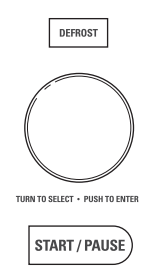
Use Auto Defrost for meat, poultry and fish weighing up to six pounds. Use Time Defrost for most other frozen foods.
Auto Defrost automatically sets the defrosting times and power levels to give even defrosting results for meats, poultry and fish
- Remove meat from package and place on microwave-safe dish.
- Press the DEFROST button twice.
- Turn the dial to the food weight, using the Conversion Guide at right. For example, dial 1.2 for 1.2 pounds (1 pound, 3 oz.)
- Press the dial to enter. Press the START/PAUSE button to start defrosting.
- Turn the food over if the oven signals TURN FOOD OVER.
- Remove defrosted meat or shield warm areas with small pieces of foil.
- After defrosting, most meats need to stand 5 minutes to complete defrosting. Large roasts should stand for about 30 minutes.
Conversion Guide: If the weight of food is stated in pounds and ounces, the ounces must be converted to tenths (.1) of a pound
| Weight of Food Enter Food in Ounces | Enter Food Weight (tenths of a pound) |
| 1–2 | .1 |
| 3 | .2 |
| 4 - 5 | .3 |
| 6–7 | .4 |
| 8 | .5 |
| 9–10 | .6 |
| 11 | .7 |
| 12–13 | .8 |
| 14–15 | .9 |
Time Defrost (Do not use the shelves when microwave cooking.)

- Use Time Defrost to defrost for a selected length of time.
- Press the DEFROST button three times.
- Turn the dial to select the time you want. Press the dial to enter.
- Press the START/PAUSE button to start defrosting.
- Turn the food over if the oven signals TURN FOOD OVER. You may change the defrost time at any time during defrosting by turning the dial. Power level is automatically set at 3, but can be changed.
- You can defrost small items quickly by raising the power level after entering the time
- . Power level 7 cuts the total defrosting time in about half; power level 10 cuts the total time to approximately 1/3. However, food will need more frequent attention than usual.
- A dull thumping noise may be heard during defrosting. This is normal when oven is not operating at High power.
- Defrosting Tips
- Foods frozen in paper or plastic can be defrosted in the package. Closed packages should be slit, pierced or vented AFTER food has partially defrosted. Plastic storage containers should be partially uncovered.
- Family-size, prepackaged frozen dinners can be defrosted and microwaved. If the food is in a foil container, transfer it to a microwave-safe dish.
- Foods that spoil easily should not be allowed to sit out for more than one hour after defrosting. Room temperature promotes the growth of harmful bacteria.
- For more even defrosting of larger foods, such as roasts, use Auto Defrost. Be sure large meats are completely defrosted before cooking.
- When defrosted, food should be cool but softened in all areas. If still slightly icy, return to the microwave very briefly, or let it stand a few minutes.
Beverage (Do not use the shelves when microwave cooking.)

- The BEVERAGE feature heats beverages from 6 to 12 ounces.
- Press once for 6–7 oz.
- Press twice for 8–9 oz.
- Press three times for 10–12 oz.
- Drinks heated with the Beverage feature may be very hot. Remove the container with care.
About changing the power level.
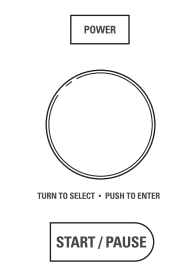
- The power level may be entered or changed immediately after entering the time for Time Cook, Time Defrost or Express Cook. The power level may also be changed during time countdown.
- First, follow directions for Time Cook, Time Defrost or Express Cook.
- Press the POWER button.
- Turn the dial clockwise to increase and counterclockwise to decrease the power level. Press the dial to enter.
- Press the START/PAUSE button to start cooking.
- Variable power levels add flexibility to microwave cooking. The power levels on the microwave oven can be compared to the surface units on a range. Each power level gives you microwave energy a certain percent of the time. Power level 7 is microwave energy 70% of the time. Power level 3 is energy 30% of the time. Most cooking will be done on High (power level 10) which gives you 100% power. Power level 10 will cook faster but food may need more frequent stirring, rotating or turning over.
- A lower setting will cook more evenly and need less stirring or rotating of the food. Some foods may have better flavor, texture or appearance if one of the lower settings is used. Use a lower power level when cooking foods that have a tendency to boil over, such as scalloped potatoes.
- Rest periods (when the microwave energy cycles off) give time for the food to “equalize” or transfer heat to the inside of the food. An example of this is shown with power level 3—the defrost cycle. If microwave energy did not cycle off, the outside of the food would cook before the inside was defrosted.
- Here are some examples of uses for various power levels:
- High 10: Fish, bacon, vegetables, heating liquids.
- Med-High 7: Gentle cooking of meat and poultry; baking casseroles and reheating.
- Medium 5: Slow cooking and tenderizing for stews and less tender cuts of meat.
- Low 2 or 3: Defrosting; simmering; delicate sauces.
- Warm 1: Keeping food warm; softening butter.
Microwave terms.
| Term | Definition |
| Arcing |
Arcing is the microwave term for sparks in the oven. Arcing is caused by:
|
| Covering | Covers hold in moisture, allow for more even heating and reduce cooking time. Venting plastic wrap or covering with wax paper allows excess steam to escape |
| Shielding | In a regular oven, you shield chicken breasts or baked foods to prevent over-browning. When microwaving, you use small strips of foil to shield thin parts, such as the tips of wings and legs on poultry, which would cook before larger parts. |
| Standing Time | When you cook with regular ovens, foods such as roasts or cakes are allowed to stand to finish cooking or to set. Standing time is especially important in microwave cooking. Note that a microwaved cake is not placed on a cooling rack. |
| Venting | After covering a dish with plastic wrap, you vent the plastic wrap by turning back one corner so excess steam can escape. |
About the sensor microwave features.
Humidity Sensor
- What happens when using the Sensor Features:
- The Sensor Features detect the increasing humidity released during cooking. The oven automatically adjusts the cooking time to various types and amounts of food.
- Do not use the Sensor Features twice in succession on the same food portion—it may result in severely overcooked or burnt food. If food is undercooked after the countdown, use Time Cook for additional cooking time.
- NOTE: Sensor features will not operate when the oven is hot. If one of the sensor cooking buttons is pressed when the temperature inside the oven is greater than 200°F, “OVEN TOO HOT FOR SENSOR COOKING--- USING ALTERNATE METHOD” will be displayed. The oven will automatically change to cook by time (follow the directions in the display) or once the oven is cool enough, the sensor features will function normally
- The proper containers and covers are essential for best sensor cooking.
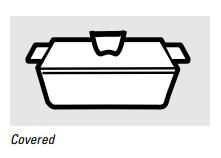
- Always use microwave-safe containers and cover them with lids or vented plastic wrap. Never use tight sealing plastic containers—they can prevent steam from escaping and cause food to overcook.
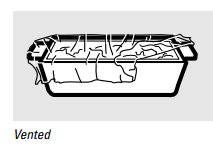
- Be sure the outside of the cooking containers and the inside of the microwave oven are dry before placing food in the oven. Beads of moisture turning into steam can mislead the sensor.
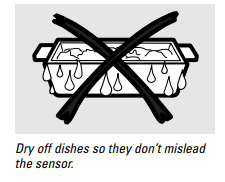
Auto Cook (Do not use the shelves when microwave cooking.)

- Because most cooking containers must be covered during Auto Cook, this feature is best with foods that you want to steam or retain moisture.
- NOTE: Use of the metal shelf with Auto Cook is not recommended
- Recommended Foods: A wide variety of foods including meats, fish and vegetables can be cooked using this feature.
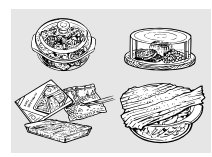
- Foods not recommended: Foods that must be cooked uncovered, foods that require constant attention, foods that require addition of ingredients during cooking and foods calling for a dry look or crisp surface after cooking should not be cooked using this feature. It is best to Time Cook them.
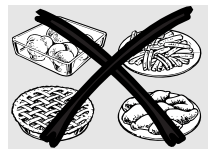
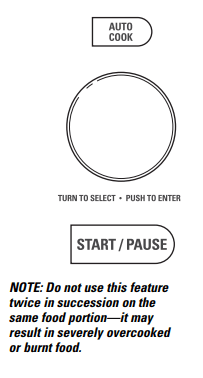
- Place covered food in the oven and close the door. Press the AUTO COOK button. ENTER FOOD TYPE appears in the display.
- Turn the dial to the desired food type. Press to enter
See the Sensor Food Type Guide below for specific foods and instructions.
The oven starts immediately.
NOTE:If the door was open while the control was being set, close the door and press the START/PAUSE button to begin cooking.
If food is undercooked after the countdown, use Time Cook for additional cooking time.
Do not open the oven door before the countdown time is displayed—steam escaping from the oven can affect cooking performance. If the door is opened, close the door and press START/PAUSE immediately.
If ground meat was selected, the oven may signal you to drain and stir the meat. Open the door, drain the meat and close the door. Press the START/PAUSE button if necessary to resume cooking
Cooking Tips
- When oven signals and countdown time is displayed, the door may be opened for stirring, turning or rotating food. To resume cooking, close the door and press START/PAUSE.
- Match the amount of food to the size of container. Fill containers at least 1/2 full.
- Be sure outside of container and inside of oven are dry.
- After completion of Cook cycle, if food needs additional cooking, return food to oven and use Time Cook to finish cooking.
How to Adjust the Oven’s Automatic Settings for a Shorter or Longer Cook Time (Not available for all food types)
- To subtract 10% from the automatic cooking time: Within the first 30 seconds after the oven starts, turn the dial counterclockwise, until a minus (“–”) sign appears, and press to enter.
- To add 10% to the automatic cooking time: Within the first 30 seconds after the oven starts, turn the dial clockwise, until a plus (“+”) sign appears, and press to enter.
Sensor Food Type Guide
| Food Type | Servings | Serving Size | Comments |
| Chicken Pieces | 1 to 4 | 2 to 8 pieces | Use oblong, square or round dish. Cover with vented plastic wrap. |
| Fish | 1 to 4 | 4 to 16 oz. | Use oblong, square or round dish. Cover with vented plastic wrap. |
| Ground Meat (Beef, Pork, Turkey) | — | 8 to 32 oz. | Use round casserole dish. Crumble meat into dish. Cover with vented plastic wrap |
| Potatoes | 1 to 4 | 8 to 32 oz. | Pierce skin with fork. Arrange in a star pattern in center of turntable. |
| Canned Vegetables | 1 to 4 | 4 to 16 oz. | Use microwave-safe casserole or bowl. Cover with lid or vented plastic wrap. |
| Fresh Vegetables | 1 to 4 | 4 to 16 oz. | Use microwave-safe casserole or bowl. Add 2 tablespoons water for each serving. Cover with lid or vented plastic wrap. |
| Frozen Vegetables | 1 to 4 | 4 to 16 oz. | Use microwave-safe casserole or bowl. Follow package instructions for adding water. Cover with lid or vented plastic wrap. |
Popcorn (Do not use the shelves when microwave cooking.)

- To use the Popcorn feature:
- Follow package instructions, using Time Cook if the package is less than 1.5 ounces or larger than 3.5 ounces. Place the package of popcorn in the center of the turntable.
- Press the POPCORN button. The oven starts immediately.
- If you open the door while POPCORN SENSOR is displayed, an error message will appear. Close the door, press CLEAR/OFF and begin again.
- If food is undercooked after the countdown, use Time Cook for additional cooking time
- How to Adjust the Automatic Popcorn Setting to Provide a Shorter or Longer Cook Time: If you find that the brand of popcorn you use underpops or overpops consistently, you can add or subtract 20–30 seconds to the automatic popping time.
- To subtract time: Within the first 30 seconds after the oven starts, turn the dial counterclockwise, until a minus (“–”) sign appears, for 20 seconds less cooking time. Press to enter. Turn again, until two minus (“– –”) signs appear, to reduce cooking time another 10 seconds for a total of 30 seconds less time. Press to enter.
- To add time:
- Within the first 30 seconds after the oven starts, turn the dial clockwise, until a plus (“+”) sign appears, for an extra 20 seconds cooking time. Press to enter. Turn again, until two plus (“++”) signs appear, to add another 10 seconds for a total of 30 seconds additional time. Press to enter.
Reheat (Do not use the shelves when microwave cooking.)
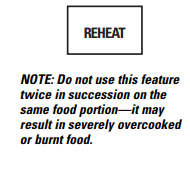
- The Reheat feature reheats servings of previously cooked foods or a plate of leftovers.
- Place the cup of liquid or covered food in the oven. Press REHEAT once, twice, three times or four times. The oven starts immediately. Press once for a plate of leftovers. Press twice for a pasta. Press three times for 1/2 to 1 full cup. Press four times for 1 to 2 full cups.
- The oven signals when steam is sensed and the time remaining begins counting down. Do not open the oven door until time is counting down. If the door is opened, close it and press START/PAUSE immediately.
- After removing food from the oven, stir, if possible, to even out the temperature. Reheated foods may have wide variations in temperature. Some areas of food may be extremely hot.
- If food is not hot enough after the countdown use Time Cook for additional reheating time.
- Some Foods Not Recommended for Use With Reheat: It is best to use Time Cook for these foods:
- Bread products.
- Foods that must be reheated uncovered.
- Foods that need to be stirred or rotated.
- Foods calling for a dry look or crisp surface after reheating.
- How to Adjust the Oven’s Automatic Settings for a Shorter or Longer Time
- To subtract 10% from the automatic cooking time: Within the first 30 seconds after the oven starts, turn the dial counterclockwise, until a minus (“–”) sign appears, and press to enter.
- To add 10% to the automatic cooking time: Within the first 30 seconds after the oven starts, turn the dial clockwise, until a plus (“+”) sign appears, and press to enter.
About the baking and roasting features.

- Baking or roasting uses a heating element to raise the temperature of the air inside the oven. Any oven temperature from 225°F to 450°F may be set. A fan gently circulates this heated air throughout the oven, over and around the food, producing golden brown exteriors and rich, moist interiors. This circulation of heated air is called convection.
- Because the heated air is kept constantly moving, not permitting a layer of cooler air to develop around the food, some foods cook faster than in regular oven cooking.
- For Best Results…
- Use one shelf in the lower position and leave at least a 1-inch gap between the cooking dish and the sides of the oven. For two-level cooking only, use both shelves.
- The shelf is required for good air circulation and even browning.
- See the Cookware Tips section for information on suggested cookware.
Bake or Roast with Preheat
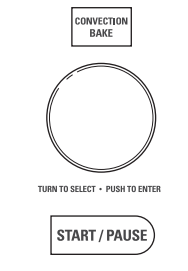
- Press the BAKE or ROAST button.
- Turn the dial to set the oven temperature and press dial to enter. Do not enter bake time now. (The cook time will be entered later, after the oven is preheated.) See the Auto Recipe™ Conversion section below.
- Press the dial or the START/PAUSE button to start preheating.
- When the oven is preheated, it will signal. If you do not open the door within 1 hour, the oven will turn off automatically.
- Open the oven door and, using caution, place the food in the oven.
- Close the oven door. Turn the dial to set the cook time and press the dial or START/PAUSE to start cooking.
- When cooking is complete, the oven will signal and turn off.
NOTE: You may change the cook time at any time during cooking by turning the dial.
You may change the oven temperature at any time during cooking by pressing the POWER button. Turn the dial to set the oven temperature and press the dial to enter.
To view the cook time and oven temperature during cooking, press the BAKE button.
Bake or Roast without Preheating
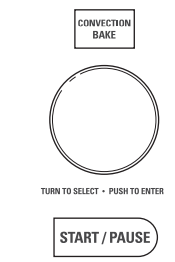
- If your recipe does not require preheating, press the BAKE or ROAST button. See the Auto Recipe™ Conversion section below.
- Turn the dial to set the oven temperature and press to enter.
- Turn the dial to set the cook time and press to enter.
- Press the dial or the START/PAUSE button to start the oven.
NOTE: You may change the cook time at any time during cooking by turning the dial.
You may change the oven temperature at any time during cooking by pressing the POWER button. Turn the dial to set the oven temperature and press the dial to enter.
To view the cook time and oven temperature during cooking, press the BAKE button.
Auto Recipe™ Conversion
- When using CONVECTION BAKE, the Auto Recipe™ Conversion feature will automatically convert entered regular baking temperatures to convection baking temperatures.
- This feature is activated so that the display will show OFFSET ON and the actual converted (reduced) temperature. For example, if you enter a regular recipe temperature of 350°F and press the START button, the display will show the converted temperature of 325°F.
- This feature can be turned off in the OPTIONS menu. See the Auto Recipe™ Conversion Selection in the About the other features section.
- NOTE: If convection baking and the Auto Recipe™ Conversion feature is turned off, reduce the oven temperature 25°F from the recipe to prevent overbrowning on the top of baked goods.
About the Fast Bake feature
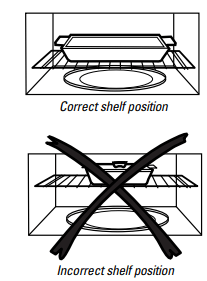
- Fast Bake offers the best features of microwave energy and convection cooking. Microwaves cook food fast and convection circulation of heated air browns foods beautifully. Any oven temperature from 225°F to 450°F may be set.
- For Best Results…
- Use one shelf in the lower position and leave at least a 1-inch gap between the cooking dish and the sides of the oven. For two-level cooking only, use both shelves.
- The shelf is required for good air circulation and even browning.
- See the Cookware Tips section for information on suggested cookware.
- See the Best Method of Cooking section to determine the which foods are appropriate to cook using Fast Bake.
Fast Bake with Preheat

- Press the FAST BAKE button.
- Turn the dial to set the oven temperature and press dial to enter. Do not enter FAST BAKE cook time now. (The cook time will be entered later, after the oven is preheated.)
- Press the dial or the START/PAUSE button to start preheating.
- When the oven is preheated, it will signal. If you do not open the door within 1 hour, the oven will turn off automatically.
- Open the oven door and, using caution, place the food in the oven.
- Close the oven door. Turn the dial to set the cook time and press to enter. Press the dial or the START/PAUSE button to start cooking.
- When cooking is complete, the oven will signal and turn off.
NOTE: You may change the cook time at any time during cooking by turning the dial.
You may change the oven temperature and microwave power level at any time during cooking by pressing the POWER button. Turn the dial to set the oven temperature and press the dial to enter. Then, turn the dial to set microwave power level 1 through 4 and press the dial to enter. The default power level is 4.
To view the cook time and oven temperature during cooking, press the FAST BAKE button.
- Check the Cookware Tips section for correct cookware when using Fast Bake.
- Do not use metal cookware with Fast Bake.
- Reduce the recipe cook time by 25%.
- See the Best Method of Cooking section to determine the which foods are appropriate to cook using Fast Bake
Fast Bake without Preheat

- If your recipe does not require preheating, press the FAST BAKE button.
- Turn the dial to set the oven temperature and press to enter.
- Turn the dial to set the cook time and press to enter.
- Press the dial or the START/PAUSE button to start the oven
NOTE: You may change the cook time at any time during cooking by turning the dial.
You may change the oven temperature and microwave power level at any time during cooking by pressing the POWER button. Turn the dial to set the oven temperature and press the dial to enter. Then, turn the dial to set microwave power level 1 through 4 and press the dial to enter. The default power level is 4.
To view the cook time and oven temperature during cooking, press the FAST BAKE button.
NOTE:
- Some recipes call for preheating.
- Check the Cookware Tips section for correct cookware when using Fast Bake.
- Do not use metal cookware with Fast Bake.
- See the Best Method of Cooking section to determine the which foods are appropriate to cook using Fast Bake.
- Reduce the recipe cook time by 25%.
Care and Cleaning
Care and cleaning of the oven.
Helpful Hints
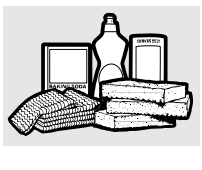
- An occasional thorough wiping with a solution of baking soda and water keeps the inside fresh.
- Be sure the power is off before cleaning any part of this oven.
How to Clean the Inside
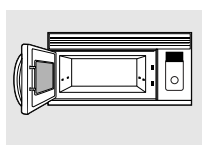
- Walls, Floor, Inside Window, Metal and Plastic Parts on the Door:
- Some spatters can be removed with a paper towel; others may require a damp cloth. Remove greasy spatters with a sudsy cloth, then rinse with a damp cloth. Do not use abrasive cleaners or sharp utensils on oven walls.
- Never use a commercial oven cleaner on any part of your microwave.

- Removable Turntable and Turntable Support
- To prevent breakage, do not place the turntable into water just after cooking. Wash it carefully in warm, sudsy water or in the dishwasher. The turntable and support can be broken if dropped. Remember, do not operate the oven in the microwave mode without the turntable and support seated and in place.

- Shelves
- Clean with mild soap and water or in the dishwasher.
- Do not clean in a self-cleaning oven.
How to Clean the Outside

- We recommend against using cleaners with ammonia or alcohol, as they can damage the appearance of the microwave oven. If you choose to use a common household cleaner, first apply the cleaner directly to a clean cloth, then wipe the soiled area.
- Case: Clean the outside of the microwave with a sudsy cloth. Rinse and then dry. Wipe the window clean with a damp cloth.
- Control Panel: Wipe with a damp cloth. Dry thoroughly. Do not use cleaning sprays, large amounts of soap and water, abrasives or sharp objects on the panel—they can damage it. Some paper towels can also scratch the control panel.
- Door Panel: Before cleaning the front door panel, make sure you know what type of panel you have. Refer to the eighth digit of the model number. “S” is stainless steel, “L” is CleanSteel and “B”, “W” or “C” are plastic colors.
- Stainless Steel: The stainless steel panel can be cleaned with Stainless Steel Magic or a similar product using a clean, soft cloth. Apply stainless cleaner carefully to avoid the surrounding plastic parts. Do not use appliance wax, polish, bleach or products containing chlorine on Stainless Steel finishes.
- CleanSteel: Use a clean, soft, light and lightly dampened cloth, then dry thoroughly. Do not use appliance wax, polish, bleach or products containing any chemical agent on the CleanSteel surfaces.
- Plastic Color Panels: Use a clean, soft, lightly dampened cloth, then dry thoroughly.
- Door Seal: It’s important to keep the area clean where the door seals against the microwave. Use only mild, non-abrasive detergents applied with a clean sponge or soft cloth. Rinse well.
- Bottom: Clean off the grease and dust on the bottom often. Use a solution of warm water and detergent.
Replacing the light bulb.
Cooktop Light/Nite Light: Replace with a 120 volt, 40 watt (max.) halogen bulb. Order WB08X10051 from your GE supplier
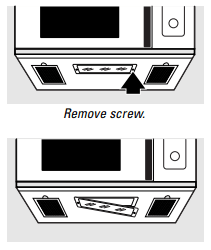
- To replace the cooktop light/nite light, first disconnect the power at the main fuse or circuit breaker panel, or pull the plug.
- Remove the screw from the side of the light compartment cover and lower the cover until it stops.
- Be sure the bulb is cool before removing. Break the adhesive seal by gently unscrewing the bulb.
- Screw in the new bulb, then raise the light cover and replace the screw. Connect electrical power to the oven
About the exhaust feature.
Vent Fan
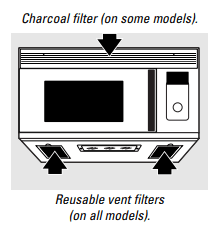
- The vent fan has two metal reusable vent filters.
- Models that recirculate air back into the room also use a charcoal filter.
Reusable Vent Filters
- The metal filters trap grease released by foods on the cooktop. They also prevent flames from foods on the cooktop from damaging the inside of the oven.
- For this reason, the filters must always be in place when the hood is used. The vent filters should be cleaned once a month, or as needed.
Removing and Cleaning the Filters
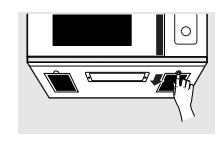
- To remove, slide them to the rear using the tabs. Pull down and out.
- To clean the vent filters, soak them and then swish around in hot water and detergent. Don’t use ammonia or ammonia products because they will darken the metal. Light brushing can be used to remove embedded dirt.
- Rinse, shake and let dry before replacing.
- To replace, slide the filters into the frame slots on the back of each opening. Press up and to the front to lock into place.
Charcoal Filter
- The charcoal filter cannot be cleaned. It must be replaced. Order Part No. WB02X10943 from your GE supplier.
- If the model is not vented to the outside, the air will be recirculated through a disposable charcoal filter that helps remove smoke and odors.
- The charcoal filter should be replaced when it is noticeably dirty or discolored (usually after 6 to 12 months, depending on usage). See “Optional Kits,” page 7, for more information.
To Remove the Charcoal Filter
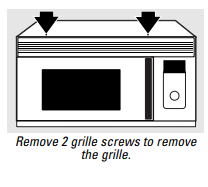
- To remove the charcoal filter, first disconnect power at the main fuse or circuit breaker, or pull the plug. Remove the top grille by removing the two screws that hold it in place.
- You may need to open the cabinet doors to remove the screws.
- Lift the filter at the bottom until it comes free of the tabs. Slide the filter down and out.
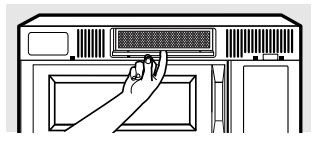
To Install the Charcoal Filter
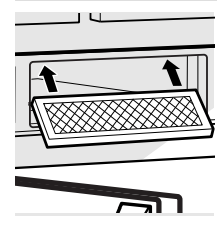
- To install a new charcoal filter, remove plastic and other outer wrapping from the new filter.
- Insert the top of the filter up and into the grooves on the inside of the top opening. Push the bottom of the filter in until it rests in place behind the tabs.
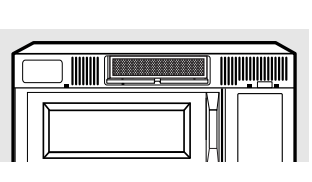
Troubleshooting Tips
Before you call for service…
| Problem | Possible Causes | What To Do |
| Oven will not start |
A fuse in your home may be blown or the circuit breaker tripped. Power surge. Plug not fully inserted into wall outlet. Door not securely closed. |
Replace fuse or reset circuit breaker. Unplug the microwave oven, then plug it back in. Make sure the 3-prong plug on the oven is fully inserted into wall ou Open the door and close securely |
| Control panel lighted, yet oven will not star |
Door not securely closed. START/PAUSE button not pressed after entering cooking selection. Another selection entered already in oven and CLEAR/OFF button not pressed to cancel it Cooking time not entered after pressing TIME COOK CLEAR/OFF was pressed accidentally. Food weight not entered after selecting AUTO DEFROST or FAST DEFROST. Food type not entered after pressing AUTO COOK |
Open the door and close securely Press START/PAUSE. Press CLEAR/OFF Make sure you have entered cooking time after pressing TIME COOK Reset cooking program and press START/PAUSE. Make sure you have entered food weight after selecting AUTO DEFROST or FAST DEFROST. Make sure you have entered a food typ |
| CONTROL LOCKED appears on display | The control has been locked. | Press and hold CLEAR/OFF for about 3 to unlock the control. |
| OVEN TOO HOT FOR SENSOR COOKING--- USING ALTERNATE METHOD appears on display | One of the sensor cooking buttons was pressed when the temperature inside the oven was greater than 200°F. | These features will not operate when the oven is hot. The oven will automatically change to cook by time (follow the directions in the display) or once the oven is cool enough, the sensor features will function normally. |
| Floor of the oven is warm even when the oven has not been used | The cooktop light is located below the oven floor. When light is on, the heat it produces may make the oven floor get warm | This is normal. |
| You hear an unusual low-tone beep | You have tried to change the power level when it is not allowed. | Many of the oven’s features are preset and cannot be changed. |
| Oven emits a smoky odor and gray smoke after using the Bake feature | Oils on the stainless steel cavity are burning off after using the Bake feature the first few times. | This is normal. |
| Food browns on top much faster than on the bottom | Rack has been placed in the “high” position. | Always use the rack in its “low” position. |
| Oven temperature fluctuates during cooking | The cooking element cycles on and off to maintain the oven temperature at the desired setting. | This is normal |
| Vent fan comes on automatically |
The vent fan automatically turns on to protect the microwave if it senses too much heat rising from the cooktop below. During Bake, Roast or Fast Bake (after preheating), the vent fan will automatically come on to cool the oven components. |
This is normal |
| SENSOR ERROR appears on the display |
When using a Sensor feature, the door was opened before steam could be detected. Steam was not detected in a maximum amount of time. |
Do not open door until steam is sensed and time is shown counting down on the display. Use Time Cook to heat for more time |
Things That Are Normal With Your Microwave Oven
- Moisture on the oven door and walls while cooking. Wipe the moisture off with a paper towel or soft cloth.
- Moisture between the oven door panels when cooking certain foods. Moisture should dissipate shortly after cooking is finished.
- Steam or vapor escaping from around the door.
- Light reflection around door or outer case.
- Dimming oven light and change in the blower sound at power levels other than high.
- Dull thumping sound while oven is operating.
- The vent fan operating while the microwave is operating. The vent fan will not go off nor can it be turned off until the microwave is off.
- TV-radio interference might be noticed while using the microwave. Similar to the interference caused by other small appliances, it does not indicate a problem with the microwave. Plug the microwave into a different electrical circuit, move the radio or TV as far away from the microwave as possible or check the position and signal of the TV/radio antenna.
See other models: JEM31GA01 CDT875M5N0S5 JVM1653SH01 PDW7300G00WW PDWT500R30BB
